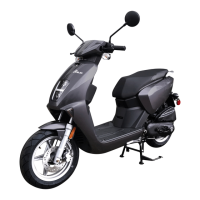
Do you have a question about the Genuine Scooter Company Brio 50i and is the answer not in the manual?
| Wheelbase | 48 Inches |
|---|---|
| Cooling | Air Cooled |
| Transmission | Automatic CVT |
| Front Brake | Disc |
| Rear Brake | Drum |
| Fuel Capacity | 1.3 gallons |
| Engine Type | Single Cylinder |
Explains warning, caution, and note symbols for safety.
Health warning regarding vehicle emissions and chemicals.
Guides on reading the manual, maintenance importance, and dealer support.
Importance of break-in and recommendations for parts and oil.
Guidelines for approved accessories and warnings against unauthorized modifications.
Information on legal requirements for noise control systems.
Emphasizes wearing helmets, apparel, and being visible to others.
Advice on riding within limits and adapting to road conditions.
Location and recording of the VIN for vehicle identification.
Location and recording of the engine serial number for identification.
How to operate the ignition switch for starting, unlocking, and locking.
Explains the function of various indicators on the instrument panel.
How to select and reset the odometer and trip odometer readings.
Instructions for setting the clock and selecting speed/distance units.
Identifies and explains the function of left and right handlebar controls.
How to use the front and rear brake levers for safe stopping.
Procedures for kick starting and unlocking the seat for storage access.
Details on under-seat storage and the utility of the bag hook.
Instructions for refueling and using the USB charging port.
Checks function, clearance, fluid, and pads for the front brake system.
Details for inspecting front/rear brake discs and pads.
Procedure to check rear brake fluid level and specification.
Inspecting throttle cable for free-play and adjustment procedures.
Checking engine oil level and oil type specifications.
Inspecting tires for wear and checking/adjusting tire pressure.
Checking cables, overall assembly, and center/side stands.
Checking fuel system, all lights, and switches for proper function.
Instructions for starting the vehicle using electric or kick-start methods.
Procedures for engine break-in and factors affecting engine life.
Guide to warming up the engine and basic riding techniques.
How to apply brakes safely and effectively for stopping.
Methods for stopping the engine and parking the vehicle safely.
Importance of periodic checks, adjustments, and lubrication.
Steps for cleaning or replacing the air cleaner and filter.
Procedure for changing the gear oil, including type and volume.
Checking transmission belt, rollers, and clutch pads for wear.
Inspecting, cleaning, and gapping the spark plug.
Inspecting brake pads and rotors for wear and damage.
Procedures for checking brake fluid level and suspension components.
Replacing fuses, battery care, and charging recommendations.
Details on engine type, displacement, bore, stroke, and cooling.
Dimensions, weight, and tire size information.
Details on engine oil, gear oil, and fuel type/capacity.
Information on ignition system, generator, and battery.
Procedure for reporting safety defects and contact information for NHTSA.
Overview of vehicle warranty coverage and where to find detailed information.